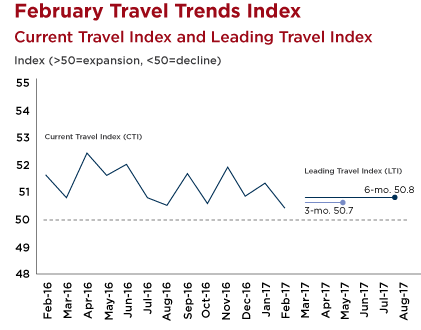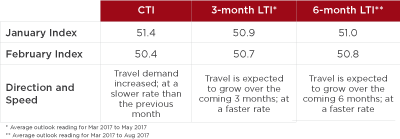WASHINGTON (April 4, 2017)—International travel again defied growth expectations in February 2017, according to the U.S. Travel Association's Travel Trends Index (TTI)—but U.S. Travel economists still warn of a drop-off in international travel going forward.
International travel data from February shows that international travel to the U.S. actually grew faster than domestic travel that month.
The February data is notable because it captures the first full month after President Trump's initial executive order on visas and immigration, issued January 27. However, U.S. Travel economists stress that because international travel is usually planned months in advance, the latest TTI is not a thorough illustration of the executive order's effect on demand for international travel to the U.S.
Said David Huether, the U.S. Travel Association's senior vice president for research: "It's important to remember that there is a significant lag time between searches for international trips and when they're actually booked, and then another lag between bookings and the actual trip—typically a matter of months. There's a lot of data out there purporting to show a drop in international travel to the U.S. because of President Trump's executive order, but the reality is we do not have a definitive data picture of the order's impact yet."
The TTI's Current Travel Index (CTI) for domestic leisure travel, normally the bastion of travel growth in the U.S., remained positive in February, but notably reflected the slowest year-over-year growth for the sector in four years. Domestic business travel growth slipped into negative territory yet again.
However, these anomalous growth patterns (international travel growing, domestic travel slowing), are expected to revert back to their previous norms in the months ahead, according to the TTI's predictive Leading Travel Index (LTI). International travel will likely decelerate, and domestic travel, both leisure and business, will resurge.
The U.S. Travel Association developed the TTI in partnership with Oxford Economics, and draws from multiple data sources to develop these monthly readings. In order to compile both the CTI and LTI readings, the organization's research team utilizes multiple unique non-personally identifiable data sets, including:
- Advance search and bookings data from ADARA and nSight;
- Passenger enplanement data from Airlines for America (A4A);
- Airline bookings data from the Airlines Reporting Corporation (ARC); and
- Hotel room demand data from STR.
Learn more about the Travel Trends Index.
Click here to read the full report.



